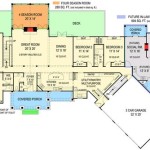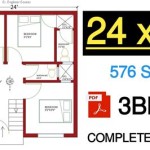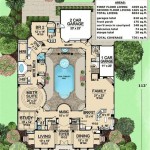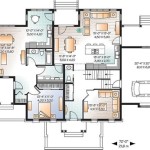Exploring the Possibilities of 10-Bedroom Single-Family House Plans
The concept of a 10-bedroom single-family house plan might initially seem exclusive to luxury estates or properties designed for specific purposes like bed and breakfasts or group homes. However, these plans cater to a variety of situations, including large extended families living together, multi-generational households, or individuals seeking extensive space for hobbies, home offices, or hosting guests. Understanding the nuances of designing and building such a large dwelling is crucial for ensuring functionality, comfort, and long-term value.
This article aims to explore the considerations involved in planning a 10-bedroom single-family house, highlighting key design elements, spatial organization, and potential challenges. Furthermore, it addresses the factors influencing cost, legal requirements, and sustainable building practices pertinent to such an ambitious project.
Key Considerations in 10-Bedroom House Design
Designing a 10-bedroom house requires a comprehensive understanding of space allocation and functionality. It's more than simply adding bedrooms; it's about creating a cohesive living environment that caters to the potential needs of all occupants. Several factors are of paramount importance:
Privacy and Zoning: With numerous bedrooms, ensuring privacy is critical. Effective zoning separates living areas from sleeping quarters, minimizing noise transfer and allowing for individual solitude. Consider clustering bedrooms into separate wings or using strategic placement to create buffers between high-traffic zones and private spaces. Soundproofing materials in walls and floors can also significantly enhance privacy.
Accessibility: Given the scale of the house, accessibility is a crucial element. Universal design principles should be incorporated to ensure that the house is easily navigable for individuals of all ages and abilities. This includes features like wider doorways, ramps, grab bars in bathrooms, and elevators or stairlifts if the house spans multiple floors. Integrating these features from the outset is more cost-effective than retrofitting later.
Common Areas: Balancing the number of bedrooms with adequate common areas is essential. A large living room, a spacious kitchen with multiple workstations, and a dedicated dining area are vital for fostering a sense of community and accommodating large gatherings. Consider incorporating additional common areas such as a game room, home theater, library, or indoor recreation space to provide diverse entertainment options. Outdoor spaces, such as patios, decks, and gardens, are equally important for leisure and relaxation.
Bathroom-to-Bedroom Ratio: A sufficient number of bathrooms is crucial to avoid congestion, particularly in the mornings and evenings. Aim for at least one bathroom for every two to three bedrooms, ideally with en-suite bathrooms for master suites and potentially shared bathrooms for other bedrooms. Consider the long-term needs of the occupants and future flexibility when planning bathroom layouts.
Traffic Flow: The layout should facilitate smooth and efficient traffic flow throughout the house. Avoid bottlenecks and long, narrow corridors that can feel claustrophobic. Consider multiple entry points and strategically placed hallways to connect different areas of the house seamlessly. Thoughtful circulation patterns enhance the overall usability and comfort of the home.
Architectural Styles and Spatial Organization
The architectural style of a 10-bedroom house can vary widely, influenced by personal preferences, site conditions, and regional aesthetics. However, certain styles lend themselves particularly well to accommodating the scale and spatial requirements of such a large dwelling.
Ranch Style: A sprawling ranch-style house can be well-suited for a 10-bedroom layout, particularly on a large lot. The single-story design promotes accessibility and allows for easy expansion. The bedrooms can be arranged in wings, with common areas centrally located. However, depending on the lot size, a ranch-style house may require a significantly larger footprint than a multi-story design.
Two-Story Design: A two-story house offers a more compact footprint compared to a ranch-style house. Bedrooms can be distributed across both floors, with the primary living areas typically located on the ground floor. Careful consideration must be given to stair placement and accessibility for all occupants. A two-story design can also offer better views from upper-level bedrooms and living spaces.
Multi-Wing Layout: This approach involves dividing the house into distinct wings, each housing a cluster of bedrooms and potentially a small living area. This can be particularly useful for multi-generational households, allowing for a degree of independence and privacy. The wings can be connected by a central common area, such as a large kitchen and dining room.
Victorian Style: While more complex to design and build, a Victorian-style house can offer an elegant and spacious layout for a 10-bedroom dwelling. The high ceilings, large windows, and intricate detailing can create a grand and luxurious atmosphere. However, Victorian houses often require extensive maintenance and can be more expensive to heat and cool.
Regardless of the chosen architectural style, the spatial organization should prioritize functionality, privacy, and accessibility. Creating a detailed floor plan that considers the needs of all occupants is crucial for ensuring a comfortable and livable home.
Cost Factors and Legal Considerations
Building a 10-bedroom house is a significant financial undertaking. The cost can vary widely depending on several factors, including location, materials, labor, and the complexity of the design. Understanding these cost factors and navigating the relevant legal considerations are essential for a successful project.
Construction Costs: Construction costs typically account for the largest portion of the budget. These costs include materials, labor, permits, and site preparation. High-end finishes, custom cabinetry, and elaborate architectural details can significantly increase construction costs. Obtaining multiple bids from reputable contractors is crucial for securing the best possible pricing.
Land Costs: The cost of land can vary dramatically depending on location and zoning regulations. A large lot is generally required for a 10-bedroom house, particularly if a ranch-style design is preferred. Investigate zoning restrictions early in the planning process to ensure that the proposed house is permitted on the selected property.
Permitting and Legal Fees: Obtaining the necessary building permits can be a time-consuming and expensive process. Local building codes and zoning regulations must be strictly adhered to. Hire a qualified architect or engineer to ensure that the design complies with all applicable regulations. Legal fees associated with property transactions and contract negotiations should also be factored into the budget.
Utility Costs: A large house will naturally consume more energy than a smaller dwelling. Invest in energy-efficient appliances, insulation, and windows to minimize utility costs. Consider incorporating renewable energy sources, such as solar panels, to further reduce energy consumption. Efficient heating and cooling systems are also essential for maintaining a comfortable indoor environment.
Property Taxes: Property taxes are typically based on the assessed value of the property. A larger, more expensive house will result in higher property taxes. Factor these ongoing costs into your long-term financial plan.
Resale Value: While a 10-bedroom house can be a valuable asset, it's important to consider its potential resale value. The market for such large properties may be limited. Research market trends and consult with a real estate professional to assess the potential resale value of the house in your area.
Navigating these legal and financial complexities requires careful planning and professional guidance. Engaging with experienced architects, contractors, and real estate professionals is essential for ensuring a smooth and successful building process.
In summary, constructing a 10-bedroom single-family house necessitates a thorough understanding of spatial requirements, architectural styles, and associated costs. A meticulous approach to design, construction, and legal compliance is crucial for realizing a functional, comfortable, and valuable property that meets the specific needs of its occupants.

10 Room House Plan Bedroom Plans Floor

10 Bedrooms House Plan With Bathrooms And 3 Car Garage

10 Bedrooms House Plan With Bathrooms And 3 Car Garage
Top 10 Duplex Plans That Look Like Single Family Homes Houseplans Blog Com

10 Marla House Plan Model N Plans

Top 15 House Plans Plus Their Costs And Pros Cons Of Each Design

10 More Small Simple And House Plans Blog Eplans Com

15 Best 10 Bedroom House Ideas Model Plan Duplex Plans Architectural

Trends Revealed June 2024 National Survey Of Single Family Housing

Two Story House Plans To Elevate Your Lifestyle Tagged Page 7








